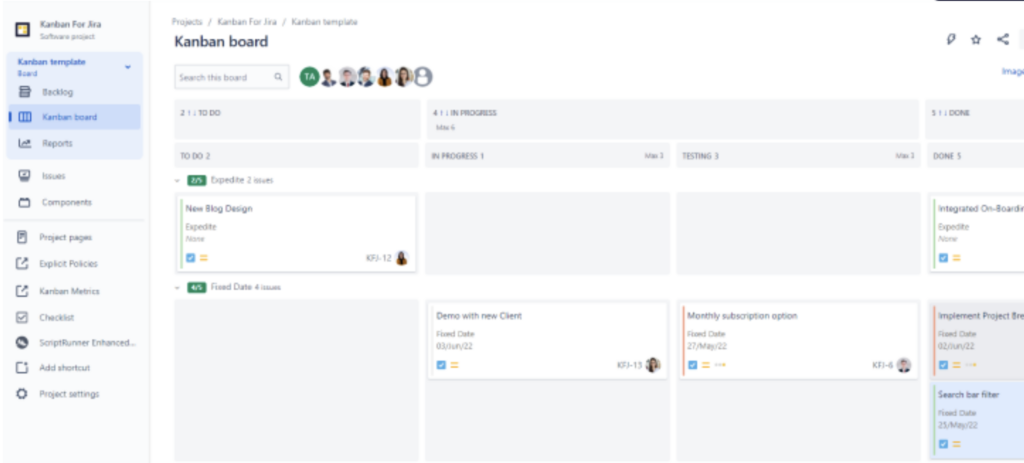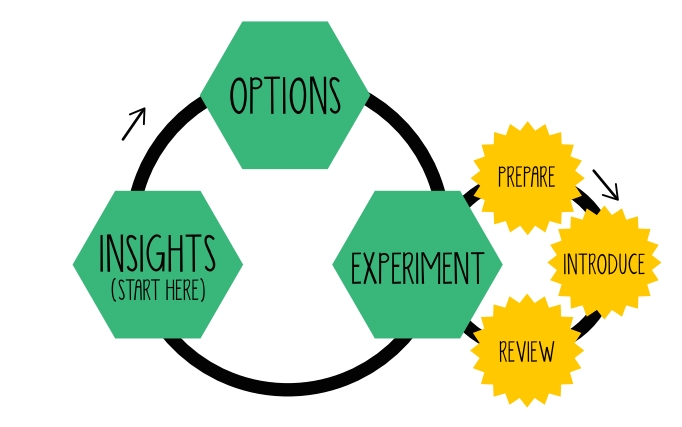Symptoms that your transformation process is stalled and possible remedies
Many organizations choose to adopt new frameworks to enhance their response speed to market demands and deliver value to users. However, these processes can sometimes stall, jeopardizing their sustainability and expected outcomes. Identifying the symptoms early and applying the right remedies is crucial to maintaining people’s engagement in the process.
In this article, we’ll explore the main signs that your transformation is stuck and how you can address them.
How to know if your transformation process is stucked
For any transformation process to succeed, organizations must continuously monitor and evaluate their progress. Below, we’ll explore some of the key symptoms indicating you’re stuck and what you can do to get back on track.
1. Dependencies are not decreasing
One of the clearest indicators that your process is stalled is the lack of reduction in dependencies between teams and tasks. In an effective agile environment, dependencies should gradually decrease, allowing for greater autonomy and faster delivery. This also signals that you are effectively promoting a culture of collaboration and an efficient organizational and operational model.
With Scrum for Jira, you can easily track and manage dependencies between teams and measure over time whether they are decreasing or not.
2. Delivery cycles are prolonging
If you notice that product or feature delivery cycles are lengthening, it’s a sign that something is not working properly. Agile frameworks should enable quick and frequent deliveries. You may not be applying them correctly, or there may be structures in your organization that prevent this agility in deliveries and hinder the new ways of working from operating as expected.
3. Increase or blockage in the number of defects
An increase in the number of defects in deliverables, or a blockage in the process of improving quality, is a symptom of problems in the transformation process. This may indicate a lack of proper testing, ineffective communication, or integration issues, as well as a culture that isn’t ideal. One situation I’ve frequently encountered is the neglect of quality because “what’s measured is how fast we deliver or how predictable we are.”
4. Low participation in retrospectives
Retrospectives are a crucial part of agility to identify and resolve problems. If you notice low participation or little enthusiasm in these meetings, it’s a sign that the team is not committed to continuous improvement or hasn’t yet seen the value in these events.
5. Lack of updates on boards
If boards are not updated regularly, it’s a sign that the team is not following agile principles. These boards are essential for transparency and visibility of progress, and their continuous updating ensures that we are having conversations focused on value delivery.
If, additionally, we detect that boards are updated only before a Review, Planning, or similar event, it means that teams don’t see the real benefit of using visual management in their daily work and are only doing it because they’ve been told to. In other words, they are not “engaged” in the transformation process.
Click here to learn more about Visual Management and how it can support your transformation.

6. Lack of continuous improvement
If no improvements are seen in processes and outcomes, it’s a sign that the team is not properly applying agile principles. Continuous improvement is fundamental to any transformation, and its absence may indicate underlying problems in the implementation of frameworks and cultural transformation.
7. Unclear roles and responsibilities
When team members lack clarity about their roles and responsibilities, team efficiency and cohesion can be severely affected. This can lead to confusion, duplication of efforts, and wasted time, as well as the aforementioned lack of trust in the transformation process and new ways of working.
8. Leaders blocking the process
Leaders who block the process can do so openly, expressing their disapproval or distrust of the new ways of working, or “behind the scenes,” through subtle actions that undermine the team’s efforts. This type of resistance to change can manifest in the refusal to adopt new practices, a lack of support for bringing in expert talent, or even in fostering a culture that perpetuates traditional ways of working. This kind of leadership response not only slows down the transformation process but also demoralizes teams, reduces cohesion, and creates an environment of uncertainty that contradicts the principles of agility.
To address this challenge, it’s crucial to have a clear strategy for engaging and properly supporting leaders in the process.
Recognizing these symptoms is just the first step. It’s equally important to understand why stalling can be so detrimental to your organization and how it can impact the long term.
Here is a link to one of our key success cases in managing these kinds of situations and driving the transformation process.

Why stalling is a problem
Stalling in a transformation process can be harmful to any organization. When a team or an entire organization becomes stuck, it not only affects operational efficiency but also erodes confidence in the process, compromising the organization’s ability to adapt to change. Change management plays a crucial role in overcoming these challenges.
Having professionals trained in change management can make a significant difference. We have the tools and knowledge necessary to guide organizations through the difficulties of transformation, ensuring that teams remain engaged and that processes are adjusted as needed. Want to learn more? We tell you everything here!
Possible remedies to revitalize your transformation process
Fortunately, there are several strategies you can implement to revitalize your transformation process. These strategies will not only help you overcome current obstacles but also strengthen your team’s ability to adapt and thrive in the future:
1. Reinforce team engagement
To address the lack of engagement, it’s essential to foster an environment where people feel valued and heard. Hold regular meetings to discuss the challenges, difficulties, and successes of the process, and provide opportunities for everyone to contribute ideas. Additionally, recognize and celebrate team achievements and validate any fears that may arise, as they are natural. This can be very beneficial for the engagement process by making them transparent.
2. Adapt the processes
Flexibility is key in an organizational transformation process. Regularly review and adjust processes to ensure they are aligned with the transformation’s needs and goals. Don’t be afraid to experiment with new practices and approaches to find what works best for your teams.
3. Improve transparency
Implement tools and practices that enhance visibility and transparency, such as Kanban boards, effective dailies, and regular retrospectives. Ensure that all team members have access to the necessary information and clearly understand the priorities and progress of the process. In this article, we explain how you can generate effective dailies with your team to increase transparency and collaboration culture in your organization.
4. Foster a culture of change
Support individuals and teams throughout the transformation process. A solid change management plan helps to adopt a culture of continuous change and build resilience. It’s important to achieve quick wins and show how results can improve with the adopted ways of working. Promote a culture of acceptance and adaptation to change through continuous training and support for experimentation and innovation.
5. Improve communication
To improve communication, establish clear and efficient channels. Use collaboration tools that facilitate communication and ensure that meetings are productive and focused. For this, it is especially effective to rely on change facilitators with experience in transformation processes.

Some examples: How do we do it?
Maturity assessments
One of the tools we love to use at TecnoFor is the maturity assessment of the transformation process. With these tools, we can map and measure where our clients are in their agility adoption over time, allowing us to develop concrete and personalized action plans aimed at getting out of a stalled state and driving the transformation process forward again.
Want to learn more about how you can conduct this assessment for your organization? If you already suspect something in your organization isn’t adapting to your customers’ needs or you’re unable to deliver the right products or services, TecnoFor offers an online form to analyze your organization’s maturity status and potential improvement and growth opportunities. Contact us here!
ADKAR model
The ADKAR model is a powerful tool for managing change and engaging people in the transformation process. ADKAR is an acronym representing five outcomes necessary for a successful transformation: Awareness, Desire, Knowledge, Ability, and Reinforcement.
There are two important aspects to consider when using ADKAR that will help unlock and drive the transformation process:
- We must work on each parameter in order: the first step is to generate Awareness (that transformation is necessary); once achieved, we can work on Desire (that people want the transformation), and so on. Something we often do is start with Knowledge, training everyone involved in the new ways of working, without having first addressed the first two points.
- The transformation is considered successful and sustainable when all ADKAR parameters have been achieved. We consider a parameter achieved when it has been absorbed by at least 70% of the people involved. ADKAR includes the necessary assessments to measure this progress.
Implementing this model can help identify, measure, and address the problems preventing progress, ensuring that every person and/or team is aligned and committed to the change objectives.
Lean change management
The Lean Change Management approach combines agile change management principles with Lean techniques. This approach facilitates more dynamic and adaptable change management, allowing for quick adjustments based on continuous feedback. By using tools like experiments, hypotheses, and feedback cycles, Lean Change Management helps organizations manage change effectively while keeping the agile process aligned with business objectives.

Conclusion
Identifying and addressing the symptoms of a stalled transformation process is crucial to ensuring the success and sustainability of the process. By reinforcing team engagement, adapting processes, improving visibility and transparency, fostering a culture of change, and enhancing communication, you can revitalize your transformation process and help your organization reach its full potential.
Remember, agility is a continuous journey of improvement and adaptation. We are here to support you along the way!
